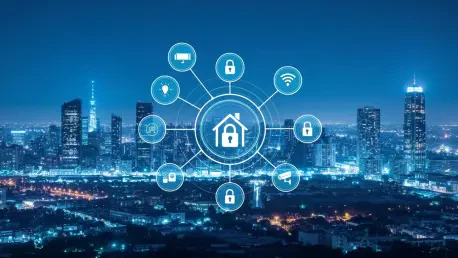In an era where homes are becoming increasingly interconnected, the smart home industry stands at a pivotal crossroads, with cybersecurity emerging as a defining factor in market success. Imagine a household where every device, from the refrigerator to the security camera, communicates seamlessly, offering unparalleled convenience—yet, this very connectivity opens the door to potential cyber threats that could compromise personal data or even physical safety. As the global smart home market is projected to grow from $216.3 billion currently to $489.2 billion by 2035, the stakes have never been higher. The proliferation of connected devices has expanded the attack surface for cybercriminals, making robust security measures not just a technical requirement but a critical competitive edge. This discussion explores how cybersecurity is reshaping the landscape of smart home technology, influencing consumer trust, and driving innovation across the sector.
The Rising Importance of Cybersecurity in Smart Homes
From Optional Feature to Core Necessity
The transformation of cybersecurity from a peripheral concern to a fundamental aspect of smart home products marks a significant shift in industry priorities. With the average household now integrating multiple connected devices—think smart thermostats, doorbells, and appliances—the risk of cyber intrusions has escalated dramatically. Industry leaders emphasize that the appeal of smart homes hinges on convenience and adaptability, but this promise is hollow if personal data remains vulnerable. Manufacturers are increasingly viewing cybersecurity as a key differentiator, where the ability to protect user information and ensure system integrity directly correlates with brand reliability. This shift is evident as companies invest heavily in security features, recognizing that a single breach can erode consumer confidence and damage reputations irreparably. The focus is no longer just on functionality but on creating a secure ecosystem that reassures users at every touchpoint.
Building Trust Through Data Protection
Consumer trust is the bedrock of the smart home market, and cybersecurity plays a pivotal role in fostering that confidence. As households adopt more devices, the potential for sensitive information to be exploited grows, making data protection a top priority for manufacturers. Beyond mere compliance, companies are embedding advanced security protocols into their products to stand out in a crowded market. The emphasis on safeguarding personal information is not just about preventing breaches but also about demonstrating a commitment to user privacy. This proactive stance helps differentiate brands in a sector where trust can be a deciding factor for buyers. Moreover, as cyber threats evolve, the industry’s response through innovative solutions signals to consumers that their safety is paramount, further solidifying loyalty and encouraging wider adoption of smart technologies.
Industry Strategies and Regulatory Impacts
Embedding Security by Design
A growing consensus among industry giants highlights the importance of integrating cybersecurity into the very foundation of smart home product design. Rather than treating security as an afterthought, leading companies are adopting a “security by design” approach, ensuring that protective measures are built into devices from the outset. For instance, robust platforms that monitor threats across multiple devices and secure storage solutions for sensitive data are becoming standard features. This preventive mindset contrasts sharply with earlier reactive strategies, prioritizing user experience by making security seamless and unobtrusive. Major players in the market are setting benchmarks by incorporating privacy controls and local data protection models, reflecting a broader shift toward creating ecosystems where safety enhances functionality. Such initiatives underscore how embedded security is not just a technical necessity but a strategic advantage in gaining consumer favor.
Navigating Regulatory Frameworks
Regulatory developments are adding another layer of urgency to the cybersecurity conversation within the smart home industry. With frameworks like the European Union’s Cyber Resilience Act set for full implementation by December 2027, manufacturers face mandates to ensure security across a product’s entire lifecycle. These regulations are not merely bureaucratic hurdles but catalysts for building consumer trust through comprehensive defenses. Compliance with such standards pushes companies to adopt multilayered protection strategies, from device-level safeguards to cloud security and user configurations. Practices like regular software updates, data encryption, and multifactor authentication are becoming non-negotiable as regulators align with industry efforts to prioritize safety. This convergence of policy and practice illustrates a shared recognition that robust cybersecurity is essential for sustaining market growth and protecting users in an increasingly connected world.
Standardization Challenges and Opportunities
The push for standardization in smart home ecosystems reveals both the potential and the hurdles of ensuring secure interoperability. Universal protocols aimed at facilitating consistent communication and security across brands have been introduced, yet adoption remains uneven due to reliability concerns and limited manufacturer integration. While major tech companies have shown commitment to these standards, delays in full support and technical challenges with underlying network protocols persist. Despite these obstacles, there is optimism that ongoing refinements will pave the way for seamless operation in the near future. The drive toward standardization reflects an industry-wide acknowledgment that without cohesive security measures, the vision of a fully integrated smart home remains incomplete. This effort to harmonize diverse systems underscores cybersecurity’s role as a unifying force in advancing technological compatibility and user confidence.
Reflecting on Cybersecurity’s Lasting Impact
Looking back, the journey of cybersecurity in the smart home sector reveals a profound evolution from a secondary feature to a central pillar of competitiveness. Manufacturers have adapted by embedding advanced security solutions into their offerings, while regulators have enforced stricter standards to protect consumers. Collaborative efforts to standardize secure interoperability have faced challenges but have laid critical groundwork for future progress. The shared commitment to safeguarding personal data and system integrity has shaped consumer trust and redefined corporate strategies. As the market expands, the nuanced balance between technological innovation and user protection becomes evident, with cybersecurity standing as an indispensable element of sustainable growth. Moving forward, the industry must continue to prioritize innovative defenses, streamline standardization, and adapt to emerging threats to ensure that the promise of connected homes remains both secure and transformative.









